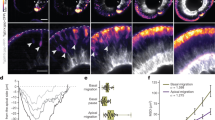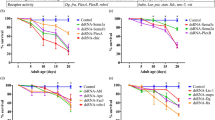Abstract
A major question in developmental neurobiology is how developing nerve cells accurately extend processes to establish connections with their target cells. This problem involves both the nature of cues for growth cone guidance and also the question of how growth cones survey their environment for cues and respond by altering their direction of migration. The filopodia which normally extend from neuronal growth cones have been shown to affect growth cone steering in vitro1–4 and it has been proposed that they function in vivo in the detection of and response to guidance cues5–10. This hypothesis could be tested in vivo if growth cones which normally have filopodia could be induced to migrate in their absence. The pair of Ti1 neurones are the first neurones to extend axons through the limb buds of embryonic grasshoppers11. We report here an examination of the migration of Ti1 pioneer growth cones deprived of filopodia by culture in agents which disrupt actin microfilaments. Under these conditions, axons continue to extend but a large percentage of growth cones are highly disoriented. Our results indicate that Ti1 filopodia are not necessary for axonal elongation in vivo but that they are important for correctly oriented growth cone steering.
This is a preview of subscription content, access via your institution
Access options
Subscribe to this journal
Receive 51 print issues and online access
$199.00 per year
only $3.90 per issue
Buy this article
- Purchase on Springer Link
- Instant access to full article PDF
Prices may be subject to local taxes which are calculated during checkout
Similar content being viewed by others
References
Bray, D. J. Cell Sci. 37, 391–410 (1979).
Bray, D. & Chapman, K. J. Neurosci. 5, 3204–3213 (1985).
Letourneau, P. C. in Molecular Bases of Neural Development (eds Edelman, G. M., Gall, W. E. & Cowan, W. M.) 269–294 (Wiley, New York, 1985).
Wessells, N. K. & Nuttall, R. P. Expl Cell Res. 115, 111–122 (1978).
Weiss, P. Symp. Soc. Study dev. Growth 5 (suppl.), 163–203 (1941).
Mason, C. Trends Neurosci. 8, 304–306 (1985).
Bastiani, M. J., Raper, J. A. & Goodman, C. S. J. Neurosci. 4, 2311–2328 (1984).
Bentley, D. & Keshishian, H. Science 218, 1082–1088 (1982).
Taylor, J. S. H. & Roberts, A. J. Embryol. exp. Morph. 75, 49–66 (1983).
Tosney, K. W. & Landmesser, L. T. J. Neurosci. 5, 2345–2358 (1985).
Bate, C. M. Nature 260, 54–56 (1976).
Caudy, M. & Bentley, D. J. Neurosci. 6, 1781–1795 (1986).
Caudy, M. & Bentley, D. J. Neurosci. 6, 364–379 (1986).
Marsh, L. & Letourneau, P. C. J. Cell Biol. 99, 2041–2047 (1984).
Yamada, K. M., Spooner, B. S. & Wessells, N. K. J. Cell Biol. 49, 614–635 (1971).
Bray, D. & Gilbert, D. A. Rev. Neurosci. 4, 505–523 (1981).
Jan, L. Y. & Jan, Y. N. Proc. natn. Acad. Sci. U.S.A. 79, 2700–2704 (1982).
Bentley, D. & Caudy, M. Cold Spring Harb. Symp. quant. Biol. 48, 573–585 (1983).
Katz, M. J. J. Neurosci. 5, 589–595 (1985).
Bentley, D. & Caudy, M. Nature 304, 62–64 (1983).
Ho, R. K. & Goodman, C. S. Nature 297, 404–406 (1982).
Keshishian, H. & Bentley, D. Devl. Biol. 96, 89–124 (1983).
Kuwada, J. Y. & Kramer, A. P. J. Neurosci. 3, 2098–2111 (1983).
Lopresti, V., Macagno, E. R. & Levinthal, C. Proc. natn. Acad. Sci. U.S.A. 70, 433–437 (1973).
Mason, C. J. Neurosci. Res. 13, 55–73 (1985).
Raper, J. A., Bastiani, M. J. & Goodman, C. S. J. Neurosci. 3, 20–41 (1983).
Roberts, A. & Taylor, J. S. H. J. Embryol. exp. Morph. 75, 31–47 (1983).
Rusoff, A. C. J. Neurosci. 4, 1414–1428 (1984).
Argiro, V., Bunge, M. B. & Johnson, M. I. J. Neurosci. 4, 3051–3062 (1984).
Author information
Authors and Affiliations
Rights and permissions
About this article
Cite this article
Bentley, D., Toroian-Raymond, A. Disoriented pathfinding by pioneer neurone growth cones deprived of filopodia by cytochalasin treatment. Nature 323, 712–715 (1986). https://doi.org/10.1038/323712a0
Received:
Accepted:
Issue Date:
DOI: https://doi.org/10.1038/323712a0
This article is cited by
-
Three-dimensional organization of transzonal projections and other cytoplasmic extensions in the mouse ovarian follicle
Scientific Reports (2019)
-
Bantam regulates the axonal geometry of Drosophila larval brain by modulating actin regulator enabled
Invertebrate Neuroscience (2018)
-
TRPM7 Regulates Axonal Outgrowth and Maturation of Primary Hippocampal Neurons
Molecular Neurobiology (2016)
-
Differential requirement of F-actin and microtubule cytoskeleton in cue-induced local protein synthesis in axonal growth cones
Neural Development (2015)
-
Cofilin 1 activation prevents the defects in axon elongation and guidance induced by extracellular alpha-synuclein
Scientific Reports (2015)
Comments
By submitting a comment you agree to abide by our Terms and Community Guidelines. If you find something abusive or that does not comply with our terms or guidelines please flag it as inappropriate.



